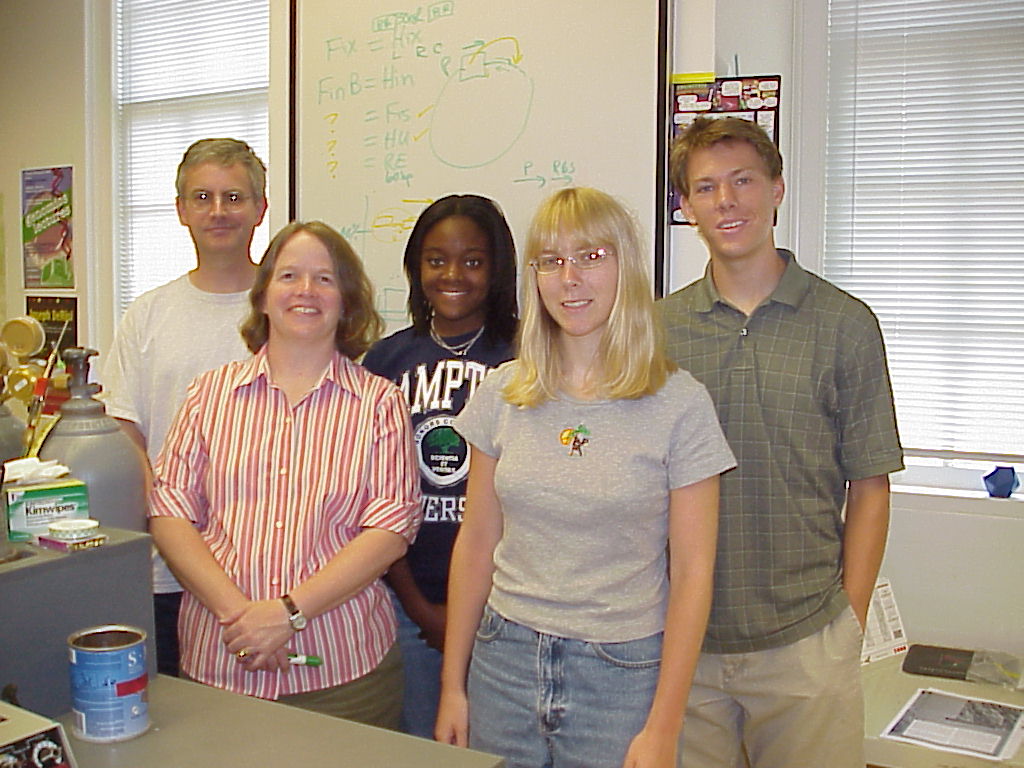Davidson 2006
From 2006.igem.org
Fizzle6821 (Talk | contribs) (→'''Questions''') |
Fizzle6821 (Talk | contribs) (→'''Questions''') |
||
| Line 61: | Line 61: | ||
[[Math Questions]] | [[Math Questions]] | ||
| - | |||
[[Biology Questions]] | [[Biology Questions]] | ||
| - | |||
| - | |||
| - | |||
| - | |||
| - | |||
| - | |||
| - | |||
| - | |||
| - | |||
| - | |||
| - | |||
| - | |||
| - | |||
| - | |||
| - | |||
| - | |||
| - | |||
| - | |||
| - | |||
== '''Assembly Issues''' == | == '''Assembly Issues''' == | ||
Revision as of 19:50, 6 June 2006

Contents |
Students
• Sabriya Rosemond [1] is a rising junior biology major at Hampton University in VA.
• Erin Zwack [2] is a rising junior biology major at Davidson College in NC.
• Lance Harden [3] is a rising sophomore at Davidson College, who might major in math.
Faculty
• A. Malcolm Campbell [http://www.bio.davidson.edu/campbell Department of Biology], [4]
• Laurie J. Heyer [http://www.davidson.edu/math/heyer/ Department of Mathematics], [5]
Papers of Interest
• [http://www.bio.davidson.edu/courses/synthetic/papers/Sanders_04.pdf Stepwise Dissection of the Hin-catalyzed Recombination Reaction from Synapsis to Resolution. Erin R. Sanders and Reid C. Johnson]
• [http://www.molcells.org/home/journal/article_read.asp?volume=16&number=3&startpage=377 The Effects of Ethidium Bromide and Mg++ Ion on Strand Exchange in the Hin-mediated Inversion Reaction. Hee Jung Lee et al.] Excellent description of Hin recombination mechanism.
• [http://www.jbc.org/cgi/reprint/267/16/11183 The Effects of Symmetrical Recombination Site hixC on Hin Recombinase Function. Heon Man Lim et al.]
• [http://www.pubmedcentral.gov/articlerender.fcgi?tool=pubmed&pubmedid=3457367 The role of the loxP spacer region in P1 site-specific recombination. Ronald H.Hoess et al.]
• [http://www.biomedcentral.com/1471-2164/7/73 A high-throughput screen identifying sequence and promiscuity characteristics of the loxP spacer region in Cre-mediated recombination. Perseus I Missirlis et al.]
• [http://nar.oxfordjournals.org/cgi/content/full/30/13/2764 Non-contact positions impose site selectivity on Cre recombinase. Andreas W. Rufer and Brian Sauer]
• [http://www.pubmedcentral.nih.gov/articlerender.fcgi?artid=103771 Growth Phase-Dependent Variation in Protein Composition of the Escherichia coli Nucleoid]
• [http://www.jbc.org/cgi/content/full/272/29/18434 Hin-mediated Inversion on Positively Supercoiled DNA]
• [http://jb.asm.org/cgi/content/full/185/3/1097 Plasmid DNA Supercoiling and Gyrase Activity in Escherichia coli Wild-Type and rpoS Stationary-Phase Cells]
Project Description

Parts Created
Questions
Assembly Issues
- What is the list of DNA parts that we will need for the first stage, second stage, entire project?
- ERIN and SABRIYA Which DNA parts exist in the registry?Answer1More Parts
- ERIN and SABRIYAWhich DNA parts will have to be designed? Will they be synthesized or produced by PCR?
loxP sites Hin/Hix CRE gene Degradation Tags
- Which plasmids will be used from the registry?
- Where would biobricks be located?
- MALCOLM What is the protocol for assembly for the first stage (restriction digestions, ligations, transformations)?
- http://www.bio.davidson.edu/courses/Molbio/Protocols/reagents.html Common molecular reagents
- [[http://www.bio.davidson.edu/courses/Molbio/Protocols/magnesium.html PCR and Mg2+ concentration]]
- http://www.bio.davidson.edu/courses/Molbio/Protocols/pourgel.html Pouring an agarose gel
- http://www.bio.davidson.edu/courses/Molbio/Protocols/molwt.html Calculate MWs
- http://www.bio.davidson.edu/courses/Molbio/Protocols/digestion.html Digest DNA with restriction enzymes
- http://www.bio.davidson.edu/courses/Molbio/Protocols/gels2002/1kbladder.pdf 1kb MW markers
- Shrimp alkaline phosphatase URL to come
- Ligation URL to come
- http://www.bio.davidson.edu/courses/Molbio/Protocols/Promegacompcells.pdf Transformation http://www.bio.davidson.edu/courses/Molbio/Protocols/transformation.html Short version
- Promega miniprep URL to come
Current Course of Action
Plasmids
- pSB1A3
- amp resistant
- copy number:100-300
- size:2157 empty
- pSB1AC3
- part-BBAp1000
- copy number:100-3000
- amp and CmR resistant
- contains device that provides CmR
- size:3844 ( with device) 3005 (without device)
- pSB1AK3
- part BBa_|13535
- copy number:100-300
- amp and kan resistance
- contains a device for screening test
- size: 3457 (with device) 3189 (without device)
- Transform bacteria We are using Salmonella typhimurium for the Hin protein as it was the referenced species in all of the literature.
- Create RE biobrick (completed)
- Isolating genomic DNA from Salmonella typhimurium
- Ordered olioges for recombinational enhancer and primers for the hin gene
